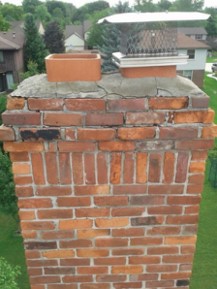As we come to the close of a prolonged heating season, have you noticed anything peculiar regarding your chimney? Are there signs of moisture either in the basement or within the masonry? Is there any noticeable physical damage? We learn from Robbinsville chimney inspections that homeowners aren’t always aware of the causes of chimney damage. The obvious causes of large objects like trees or even lightning strikes are hard to miss but there are other reasons for a chimney to require repair. Let us explore why this aspect of our home should never be neglected when it comes to proper home maintenance.

Causes of Chimney Damage | Moisture
Rain doesn’t have to be torrential and the damage it produces can take a long time. Metal caps and flus are going to notice the prolonged exposure to moisture. No matter how well designed, water molecules will form condensation and eventually rust even though the metal is encased in masonry. The chimney flu is changing temperature constantly and attracting moisture and evaporating it again. The integrity of the metal will undergo a slow process of breaking down and over time need to be replaced.
Bricks and cement also suffer from water erosion. Once again the constant exposure to the elements will eventually form small cracks and fissures in the masonry. This can also contribute to a compromised flu, but more serious is the structural stability of the chimney. Here the inspection needs to be very thorough. The weight of even a single story chimney (approximately fifteen feet) is over five thousand pounds. With weakened mortar and bricks it may be difficult to prevent that much mass moving once it gets started.
What About Wind?
Can a strong wind actually take down a chimney? Hopefully the construction of your chimney is designed to handle the typical wind activity in the area you live. Most homes that we see impacted by tornados or hurricane force winds still show at least part of the chimney still standing. By design they should withstand the wind, but the wind over time has as much to do with the slow erosion of the bricks and mortar as the rain and snow.
Working in tandem these two elements can erode a mountain, so it is smart to consider the prolonged affect they’ll have on your home. Some argue that the best position for the chimney might be on the eastern side of the home since winds tend to primarily blow from the west. For most of the structure this seems logical, but the chimney to be effective has to extend above the roofline. Up there it has no protection at all which is why the inspections usually start from top to bottom.
Causes of Chimney Damage | Defects Unseen
Now that we’ve talked about mostly visible signs of chimney damage, we should also consider the possibility of defects in materials or workmanship. All building materials are subject to careful scrutiny for possible defects. Builders are also subject to series of inspections during the various phases of construction. From the foundation to the roof every part of a carefully constructed building remains susceptible to undetected flaws in materials and workmanship. Despite how careful we are putting it together, we simply expect it is going to need maintenance.
Like the natural elements mentioned above, interior defects are still one of the common causes of chimney damage. Typically we won’t notice these defects or the damage they cause until after the life cycle prescribed by the manufacturer. Are you aware of what that life expectancy is for the chimney on your home? Why not give us a call today and allow us to look at it for you? Not only can we confirm the soundness of the chimney but we can offer some tips for keeping it in good shape.
NJ Chimney Repair
Mercer County Chimney Sweep
Related NJ Chimney Sweep Posts:
Pennington Chimney Sweep
Mercer County Chimney Repair Service
Pennington Chimney Masonry Repair
Princeton Chimney Repair
